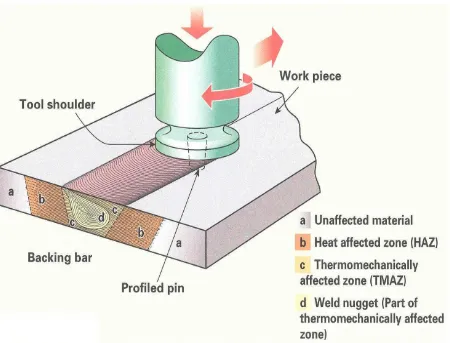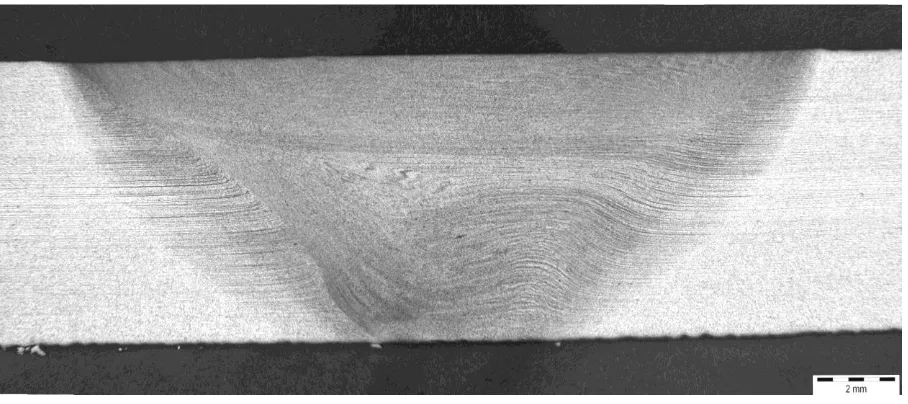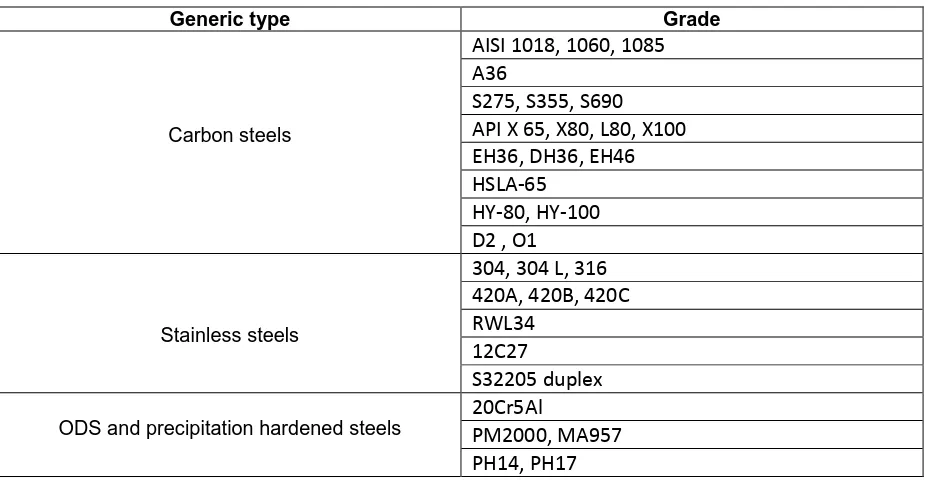Title: Friction stir welding of steel for marine applications
Authors: Athanasios Toumpisa, Alexander Gallowaya, Stephen Caterb, Paul Burlingb Chris Stanhopeb
a
University of Strathclyde, Glasgow, United Kingdom
b
TWI Technology Centre (Yorkshire), Rotherham, United Kingdom
Corresponding Author details:
Stephen Cater FRIN MEI
Friction and Forge Processes Department
Joining Technologies Group
TWI Technology Centre (Yorkshire)
Advanced Manufacturing Park
Wallis Way
Catcliffe
Yorkshire
S60 5TZ
E-mail:
stephen.cater@twi.co.uk
|
Tel. 0114 269 9046
http://www.twi.co.uk
*******
Abstract
Friction Stir Welding is a solid state welding process widely used to fabricate aluminium, magnesium and copper structures across a broad range of industries where high strength welds are required in safety critical applications. Work is underway to transfer the process into the fabrication of steel structures, bringing to steel fabrication the benefits of high strength, low distortion, enhanced fatigue life and improved toughness. These property enhancements are of particular benefit to the marine sector, where the additional abilities of the FSW to join dissimilar steels, for example carbon to stainless, and its potential reduced susceptibility to hydrogen embrittlement are also likely to be of great interest. This paper reports work undertaken as part of the EU funded project HILDA, an investigation into the potential of FSW to be utilised for the fabrication of ship structures from 6mm thick DH36 steel.
*******
Friction stir welding of steel for marine applications
In 1991 friction stir welding (FSW) was invented at TWI by Wayne Thomas. FSW is a solid state process more akin to forge welding than to casting and was originally developed for the welding of aluminium and magnesium which are considered to be rather more difficult to fusion weld than many other materials – e.g. iron and steel.
of around two thirds the melting point of the metal, the tool begins to traverse along the joint interface, transferring metal across the joint line. As the tool moves on this transferred metal cools and is consolidated by the forging action of the tool shoulder, resulting is a solid state weld being formed. The material in the vicinity of the joint undergoes metallurgical change, being worked and experiencing various degrees of heating, recovery and recrystallization according to its position and the local temperatures attained. Surface quality of the weld is excellent, and distortion is low, as can be seen in Figure 2, a weld made, in a single pass, in 6 mm thick steel.
Friction stir welding has been shown to have many benefits, both in terms of the weld itself and the economics and ease of application of the welding process. It has therefore quickly become the process of choice for the fabrication of aluminium and magnesium structures as diverse as aircraft wings and fuselages, automotive wheels and roof boxes, space rockets, fast ferries and catamarans, train carriages and iMac computers.
Amongst the proven benefits of the FSW process are:
Very good mechanical properties in the as-welded condition
Weld induced distortion is very low
Post welding cleaning and machining is minimal
No requirement for filler metal
No requirement for shielding gas when welding aluminium or magnesium
Able to weld aluminium up to 75mm thick in a single pass
No ultra-violet of electromagnetic radiation
No molten metal hazard
No fumes
Can weld vertically and upside down as there is no gravitational effect on the weld zone
The process works underwater
The process is mechanised and requires less operator skill than fusion welding
The process is repeatable
The process uses less energy and has reduced environmental impact than fusion welding
Given the many technical, environmental and economic advantages of the friction stir welding process, TWI and other research centres have sought to introduce the process to the welding of steel. Successful friction stir welds in steel were made by Thomas et al at an early stage in the development of the FSW process but these were limited in size by the difficulties faced in developing effective tools for stirring steel. However, within the last few years tool development has made some significant steps forward and it has become possible to make industrially useful lengths of weld in steel by the friction stir welding process. The FSW process is still relatively immature in steel, and the welds made expensive, but evidence is emerging that the welds made have considerably enhanced properties that can partially offset their current high cost. Work is ongoing to improve the tools yet further and bring down their cost.
FSW of steel is expected to deliver substantial commercial and technical benefits to the marine manufacturing sector such as reduced pre-weld preparation and re-work, manpower savings, scope for redesign of assembly lines, and low distortion, high quality welds of excellent fatigue properties. In one example from FSW of aluminium, Norwegian shipyard Fjellstrand reported that “using prefabricated FSW panels has enabled a 40% increase in production capacity and turn-over at the yard”. Issues associated with setup, fixture and tooling costs along with reduced health and safety, training, consumable and material usage costs compared to conventional fusion welding techniques should also influence the introduction of this innovative welding process in industry if it can be transferred into welding steel. There are a number of currently identified obstacles, deeper scientific understanding of the process on steel, engagement with the shipbuilding industry, use of fillet welds, different thicknesses and joint design, which will be required to overcome before full acceptance of the process is achieved.
Work at TWI has shown that friction stir welding is capable of welding all the grades of steel attempted to date, including those such as ODS (Oxide Dispersion Strengthened) or high carbon tool steels that are considered difficult or even impossible to weld satisfactorily by fusion techniques. The joining of dissimilar grades of steel appears to present no major obstacles, for example carbon steels have been welded to stainless steels. A major benefit is that when friction stir welding duplex stainless steels the austenite:ferrite phase balance is retained, thus the indications are that the corrosion performance of the weld will match that of the parent material. Table 1 shows a range of steels that have successfully been friction stir welded.
A significant effort is now underway to begin generating mechanical property and microstructural data for friction stir welds in typical marine engineering steels such as DH36. This latter task is of vital importance if the process is to be adopted for the fabrication of steel structures and for a variety of reasons. Of primary importance, friction stir welds will not be permitted in safety critical steel structures if their performance is an unknown quantity. To assist in establishing this, Lloyds’ Register is a partner in the HILDA consortium and involved in the development of classification guidelines for the process.
Microstructural characterisation is the first experimental step towards establishing the limits of the FSW process. It is a fundamental stage as, through its relationship to predicting the mechanical properties of the weld, an understanding of the microstructure develops important information regarding the properties that are likely to be attained in the weld zone. A secondary outcome of the microstructural assessment is to provide information related to undesirable process induced defects or flaws that could compromise the integrity of the weld, the absence of which provides reassurance that the weld process parameters reported will lead to an acceptable level of quality. A summary of these features are reported herein.
To assess microstructure, samples were transversely sectioned from a random position within the steady state condition region of each of nineteen 2m long test welds. These welds were made using different welding parameters, and fell broadly into three classes: slow welds made at welding speeds below 200 mm/min, intermediate welds made at speeds between 200 and 400 mm/min, and fast welds made at speeds between 400 and 700 mm/min. In the steady state region, the forces that the FSW tool sustains stabilise, the weld quality is improved, and any sample removed from any position within the steady state region is expected to be representative of the properties of the entire weld. The region of steady state condition is commonly identified by visual observation of the welded plates (a good quality surface without excessive flash formation, voids or cracks), and confirmed by analysis of the forces (on the longitudinal and vertical direction) on the tool; this is typically established beyond the first 150 mm of welding.
seen, the macrostructure is relatively fine grained with no evidence of the large heat affected zone , grain growth and solidification & shrinkage defects associated with traditional fusion welding.
More detailed examination was performed with the aid of a light optical microscope that involved taking several micrographic images from each sample being studied. The following nomenclature is adopted in the present study and the main regions of the weld zone are illustrated in Figure 1, where:
AD: Advancing side, the side where the rotating FSW tool pushes the metal towards the weld direction, i.e. forwards. The convention employed for the entire project is that samples are prepared so that the advancing side is presented on the left side of all images.
RT: Retreating side, the side where the rotating tool pushes the metal in a direction opposite to the weld direction, i.e. backwards.
TMAZ: Thermo-mechanically affected zone in which the material has been thermo-mechanically stirred.
Weld root: part of TMAZ, around and below the tip of the FSW tool’s pin.
HAZ: Heat affected zone, where the metal has been affected by heat but not mechanically stirred.
PM: Parent material, metal not affected by the process.
The group of slow welds presented a very homogeneous microstructure without any flaws. These exhibited a ferrite rich microstructure with highly refined grains of random geometry. A very small content of acicular-shaped bainitic ferrite was in one of the slow speed welds (Figure 4a), the content of which was seen to steadily increase with increasing traverse speed and constant rotational speed (200 rpm). This observation suggests that the cooling rate is increasing with increasing traverse speed. Additionally, there appears to be a threshold value of approximately 130 mm/min above which acicular-shaped bainitic ferrite appears at a small ratio relative to the above described ferrite rich microstructure.
In the intermediate group of welds with rotational speed of 400 rpm and as traverse speed is seen to increase, the microstructure becomes more heterogeneous, with regions of increasing bainite content (suggesting an increased cooling rate). However, this heterogeneous microstructure does not seem to have a significant effect on the mechanical properties. Still, one intermediate weld is very homogeneous, with an acicular-shaped bainitic ferrite microstructure (Figure 4b); this would suggest that a good balance of rotational and traverse speed has been achieved. Overall, the FSW process appears to be tolerant to welding speed variations at the 450 rpm rotational speed. Both welds in this intermediate group exhibit a homogeneous, fully acicular-shaped bainitic ferrite microstructure with prior austenite grain boundaries as shown in Figure 4c.
At the fast welding speed of 500 mm/min and above, the microstructure of all five welds becomes very heterogeneous, with poorly mixed regions of acicular ferrite and varying bainite content. The presence of bainite has increased considerably in this group due to the even higher cooling rate that it is expected to occur. Prior austenite grain boundaries are easily detected on the regions of bainite predominant microstructure. Two distinct microstructures co-exist within the TMAZ of one of the fast welds (Figure 4d); these would be expected to act as stress concentration regions. Yet, this weld’s parameters seem to have achieved a good balance of traverse and rotational speed that is translated into satisfactory tensile behaviour. This could be attributed to the grain refinement and a suitable ratio of microstructures overtaking the negative effects of heterogeneity.
others flaws are detected in the bulk of the weld zone (TMAZ), and especially in the top advancing side where the shear forces on the metal are expected to be the highest. Hence, high speed FSW of steel grade DH36 is feasible; the process is tolerant to parameter variation in low and intermediate speeds but less tolerant at the highest speed (500 mm/min).
Mechanical property assessment
Sixty transverse tensile tests (extracted from the slow, intermediate and fast weld speeds) were performed on an Instron 8802 servo-hydraulic uniaxial tensile testing system in accordance with ISO Standards. The following general results were observed:
All slow and intermediate weld samples failed in the parent material in a typical ductile fracture. This suggests that these fifteen sets of weld parameters produced welds of higher strength than the parent material.
Four out of the five fast welds failed in the outer boundary of the advancing side of the weld zone in a brittle manner. This fracture region appears to correspond to the top AD TMAZ region where non-metallic inclusions were found to be interconnected in an incomplete fusion characteristic (i.e. cracks).
One of the fast welds failed in the parent material although exhibiting a very heterogeneous microstructure with possible stress concentration regions. It would appear that this set of parameters achieves a good balance of rotational speed (sufficient heat input for proper thermo-mechanical stirring) and traverse speed (affecting the cooling rate which governs the ratio of phases) to produce acceptable quality welds.
Concluding remarks
Friction stir welding of steel has been shown to technically possible, capable of producing welds whose properties can exceed these of fusion processes and is a technique that is demonstrating a useful degree of industrial robustness. Though the friction stir welding of steel is still considerably more expensive than conventional arc welding processes, and is likely to remain so for some time, for a growing number of applications that require enhanced weld properties it is now approaching economic viability. The ability of the process to produce excellent welds underwater, and also to produce welds that are likely to be tolerant of radiation induced damaged, is generating considerable interest in the marine and nuclear engineering communities. As the process is mechanised, it can also be performed robotically, further opening the prospect of fabrication and repair applications where it would not be possible to undertake manual welding, for example deep underwater, inside reactor shells and in nuclear fuel storage ponds.
In terms of technical achievements,
The welding (traverse) speed has been increased substantially compared to almost a year ago. Welds speeds have been raised from 100 mm/min to in excess of 500 mm/min. This represents considerable potential economic advantages in terms of the competitiveness of FSW to conventional fusion welding processes.
An initial understanding of the relationship between weld parameters and the effect of these on weld microstructures and mechanical properties has been established. From this, it is evident that FSW generates a very complex metallurgical system.
A number of weld parameters have been identified which may produce very fast welds of acceptable quality that are highly competitive to conventional fusion welding techniques, and a programme of classification compliance testing is currently being planned in collaboration with Lloyd’s Register.
A detailed thermo-mechanical deformation study has been undertaken, generating data not previously available for steel grade DH36, and serving as a fundamental building block for a local microstructural numerical model.
Key aspects of FSW of steel such as fillet welds, design and development of new tool materials and controlled heating and cooling through the use of backing strips have been identified as highly worthy of further examination.
Acknowledgements
Figure 4. Microstructure of mid-TMAZ [x1000, Etched] (a) Slow; (b) Intermediate 1; (c) Intermediate 2; (d) Fast
Acicular-shaped bainitic ferrite Acicular ferrite
(a) (b)
(c) (d)
Acicular-shaped bainitic ferrite
Prior austenite grain boundaries
Acicular-shaped bainitic ferrite
Table 1 A range of steels that have been friction stir welded
Generic type Grade
Carbon steels
AISI 1018, 1060, 1085
A36
S275, S355, S690
API X 65, X80, L80, X100
EH36, DH36, EH46
HSLA-65
HY-80, HY-100
D2 , O1
Stainless steels
304, 304 L, 316
420A, 420B, 420C
RWL34
12C27
S32205 duplex
ODS and precipitation hardened steels



![Figure 4. Microstructure of mid-TMAZ [x1000, Etched] (a) Slow; (b) Intermediate 1; (c) Intermediate 2; (d) Fast](https://thumb-us.123doks.com/thumbv2/123dok_us/1651445.118677/10.595.72.452.106.394/figure-microstructure-tmaz-etched-slow-intermediate-intermediate-fast.webp)
